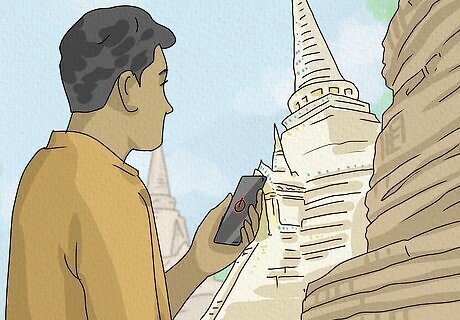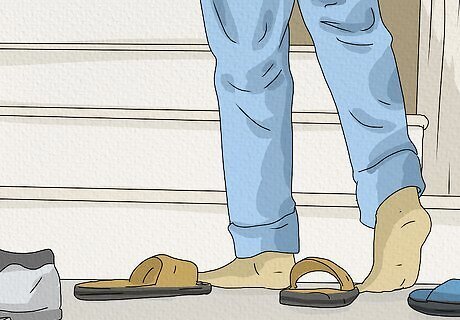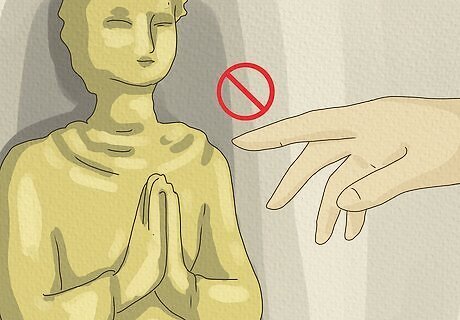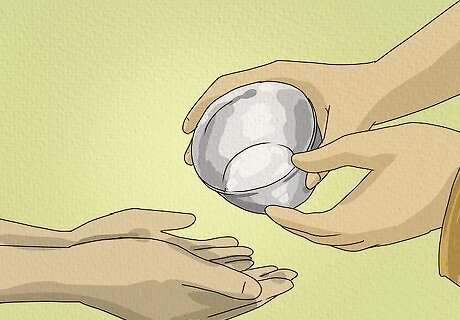
views
- Take a shower and put on loose, modest clothes that cover your shoulders, back, and knees before you head to the temple.
- Remove your shoes before you enter, and refrain from taking photos, chewing gum, or talking loudly once you’re inside.
- Work clockwise through the temple and use your right hand or both hands to give a priest small offerings, like flowers, to be placed before each statue.
Preparing to Visit the Temple

Take a shower or a bath before you visit. Everyone is welcome to visit most Hindu temples, but practitioners of the Hindu faith ask that you come washed and clean. The temple is where many Hindu deities are enshrined, and you want to present your best self. It’s a bit like visiting an esteemed elder—you wouldn’t want to show up disheveled, and a neat appearance shows your respect. To prepare yourself mentally and spiritually, also take a moment to reflect on your visit and what you hope to experience. If you practice the Hindu faith, reflect on God or the deities present in the temple you’re visiting.

Cover your shoulders and back, or wear traditional clothing. Ideally, women wear saris or punjabis into the temple (or just a long dress, if you’re a young girl). Men wear a kurta (a loose shirt) and dhoti (a type of trousers) or regular pants. If you don’t have these, don’t worry—dress as modestly as you can in loose-fitting clothes that allow you to sit cross-legged, making sure to cover your shoulders, back, and knees, at minimum. Also, opt for pants or long dresses—shorts and skirts are often considered a bit too revealing. Avoid wearing leather or animal skin of any kind; this could be offensive to practicing Hindus. Some temples even suggest wearing clothing without seams, so call ahead to confirm the temple’s dress code. Some temples let visitors borrow shawls or other clothing if they come underdressed.

Buy offerings like fruits to bring to the temple. When you visit someone’s home—especially the home of a deity—it’s best not to come empty handed. Pick up some dates, other fruit, or flowers at a local market. Or, come with fine cloth or sweets. Presenting your offerings to the temple deities is a form of respect. Hindus believe that offerings like these will please the Gods and may result in blessings and fulfilled prayers. Vendors generally set up makeshift shops in the surrounding area to sell various things that you might offer the statues. Offerings often aren’t required; if you feel nervous or can’t buy them for any reason, don’t feel pressured to do so.
Entering the Temple

Turn off your phone and display your best self. The temple is a sacred, holy space, so practice polite, constrained behavior when visiting. Before you enter, turn off or silence your phone and throw out any gum or other trash you might carry. Lower your voice and avoid loud conversation or laughter. Put away any cameras, as photography is often not permitted within the temple. Also extinguish any cigarettes, and leave alcohol outside. In addition, avoid any displays of affection, like holding hands, hugs, or kisses within the temple. This is a space for respecting the deities, so give the building and its features your full attention.

Remove your footwear outside the temple. Most temples will have a space designated for your shoes: usually a series of cubby-holes along one of the temple’s exterior walls. Take off your shoes to show respect for the temple and the deity statues within. This is not optional: removing shoes, sandals, or any other footwear is a mandatory rule of every Hindu temple. Most temples permit wearing socks, especially in cold weather, but be advised that the floors are often slippery, so tread carefully!

Approach the leftmost shrine and work clockwise around the temple. Traditionally, upon entering a Hindu temple, you’ll see an array of deities and statues arranged around the temple walls. Once inside, begin with the deity on your left. From there, continue to walk through the temple in a clockwise direction, pausing before each deity you come across. This circular route helps devotees shed stress and clear their minds. Many temples have separate queues for men and women, and you may have to follow it accordingly. Call ahead and ask if this is the case, so you know what to expect. As you enter, a priest may offer to place a small mark on your forehead (usually made from ash or turmeric), symbolizing purification. You may accept or decline as you feel comfortable; the mark does not necessarily indicate a belief in the Hindu religion. If you like, ring the brass bell at the entrance to alert the deities to your entrance. You might also “pay obeisance” by prostrating and touching your forehead to the ground at the entrance, though this is usually only done by practicing Hindus.
Moving Through the Temple

Bow before each statue you pass. As you come across each statue, join the palms of your hands near your heart into a “namaskara” (a traditional pose) and bow. This is the minimum act you should perform in front of each statue as a respectful gesture. Practicing Hindus often bow or fully prostrate themselves in front of statues as a sign of respect and reverence. If you feel comfortable, prostrate yourself as well, although it’s not required. If you do prostrate or sit before a statue, avoid pointing your feet in its direction. Feet are generally seen as unclean, and pointing them at a statue may be seen as disrespectful.

Avoid touching the shrines or statues. A single temple can house hundreds of statues—do not attempt to touch any one of them; this is seen as an inappropriate and disrespectful act. Also, never enter the cove or space that houses each shrine or statue. In Hindu faith, only priests are permitted to touch the statues and enter these spaces. Keep a respectful distance unless a priest invites you to take a closer look. In the Hindu faith, each statue is like an “antenna” that receives its corresponding deity, so it’s important to treat them with respect.

Give your offerings to the temple priest at each statue. If you brought fruit or flowers to offer to the deity, offer them as you encounter each shrine. Use your right hand or both hands to pass the offerings to the priest sitting outside the idol’s chamber. Using your left hand to give or receive any objects within the temple is considered impure. If there is no priest outside the chamber, there may be a nearby platform for worshipers to place their offerings on.

Accept any items or offerings from the temple priests. While you are in the temple, you may notice a priest pouring water over the hands of worshipers. This is a spiritual, purifying gesture: if the priest offers you the water, let him pour it over your hands. The priests may also give “prasadam,” or blessed food (which is always vegetarian) which is also offered to the deities. Hold onto the prasadam to eat outside of the temple. Remember to accept anything the priests offer you with your right hand or both hands, and never your left.

Participate in the temple prayers if you visit during an event. Worship in Hindu temples often takes place in a separate area, but might sometimes be held in the main chamber. If you like, listen along as the priest offers "puja," or prayer. This prayer can take many forms, but you often won’t need to be an active participant, so have a seat and appreciate the mantras and music. During some prayers, a priest may pass around a lamp. Hold your hands over the lamp as it passes, then touch your fingertips to your eyes to receive the blessing. While Hindus often create altars in their own homes, public temples are places to encounter community and others on their spiritual journeys. If a public prayer is being performed during your visit, be extra sure to remain respectful and attentive.

Offer a donation, if desired. As you make your way through the temple, you may see a small donation box. If you feel like donating, place them in the donation box with your right hand. Remember that donations are never required and you do not have to donate if you can’t or don’t want to for any reason.

Donate to beggars outside the temple, if you’re comfortable doing so. Depending on your location, you may find many beggars outside temples. You don’t have to give them cash if you don’t want to, but sharing offerings with the needy is generally viewed favorably. Food or leftover offerings from the temple make great donations. Only interact with strangers when you’re in a group, and avoid doing so if you’re traveling alone. It’s important to stay safe and within view of a traveling partner or tour guide when in a foreign country.




















Comments
0 comment